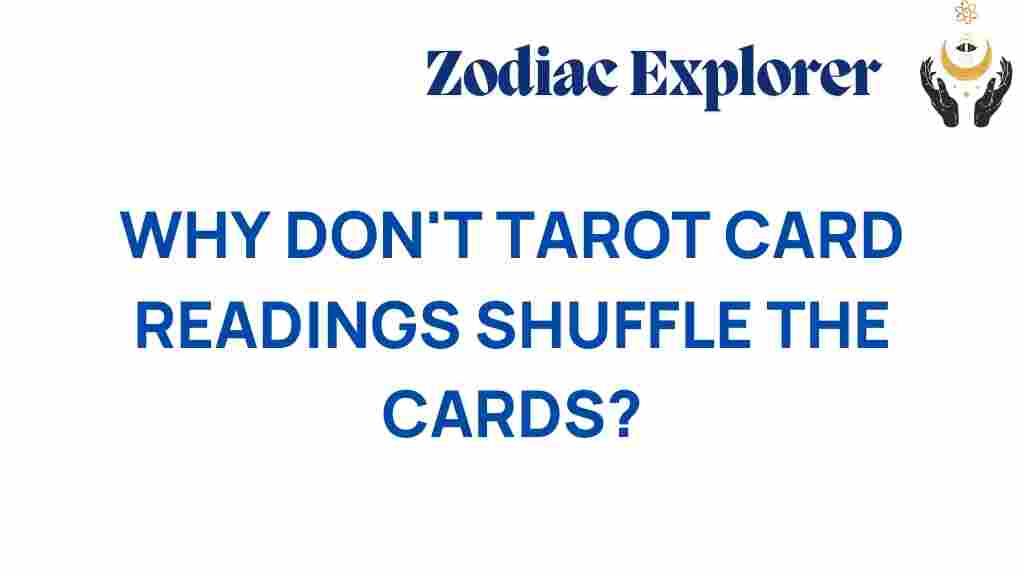Unlocking Secrets: Why Tarot Card Readings Don’t Shuffle the Cards
Tarot card readings have long captivated those with a keen interest in spirituality, mysticism, and divination. The act of interpreting the symbols and archetypes present in each card can provide profound insights into one’s life, emotions, and future. While many practitioners may follow traditional methods of shuffling, there’s a growing conversation around the idea that *tarot card readings* do not necessarily require shuffling the cards. This article explores the significance of shuffling—or the lack thereof—within the context of tarot readings, focusing on symbolism, intuition, and interpretation.
The Spirituality of Tarot Card Readings
At its core, tarot is a tool for divination, allowing individuals to tap into their intuition. Each card in the tarot deck is rich with symbolism and archetypes that resonate with our inner selves. When embarking on a tarot card reading, one must consider the following:
- Spiritual Connection: The practice is often seen as a bridge between the conscious mind and the spiritual realm.
- Intuitive Insights: Many tarot readers rely on their intuition to guide the interpretation of the cards.
- Symbolism of Cards: Each card has a unique meaning that contributes to the overall narrative of the reading.
Tarot card readings are more than just a psychological exercise; they are a means of connecting with deeper aspects of our psyche and the universe.
Understanding the Role of Shuffling
Shuffling is traditionally viewed as a necessary step in preparing for a tarot reading. It is often believed to mix the energies of the cards and the querent (the person receiving the reading). However, some practitioners argue that shuffling may not be essential to the effectiveness of a reading. Here are some perspectives to consider:
- Energy Transfer: The act of shuffling is thought to infuse the cards with the querent’s energy.
- Randomization: Shuffling introduces randomness, allowing for an unbiased selection of cards.
- Intuition Over Mechanics: Some practitioners emphasize the importance of intuition over mechanical processes.
The question remains: Can a tarot card reading be effective without the conventional shuffling of cards?
Alternatives to Shuffling in Tarot Card Readings
While shuffling is a common practice, various alternatives can be employed in tarot card readings. These methods often align more closely with intuition and the spiritual aspects of the practice.
1. Cutting the Deck
Instead of shuffling, the querent can cut the deck into parts. This method allows them to select cards from different sections, ensuring that their energy is still present in the reading.
2. Selecting Cards Intuitively
Some readers prefer to lay out the cards face down and allow the querent to choose cards based on their intuition. This process can feel more personal and connected:
- Encourages active participation from the querent.
- Promotes a deeper connection to the cards.
3. Using a Spreads Method
Spreads are specific layouts for card readings that can be used without shuffling. Each position in the spread holds a specific meaning, and the placement of the cards can guide interpretation.
Symbolism and Archetypes in Tarot
Understanding the symbolism and archetypes inherent in tarot cards is crucial for effective interpretation. Each card tells a story and represents various aspects of the human experience:
- Major Arcana: Represents significant life events and spiritual lessons.
- Minor Arcana: Focuses on day-to-day events and experiences.
By interpreting these symbols, tarot readers can derive meaning beyond the surface, tapping into universal themes that resonate with the querent’s life journey.
Common Symbols in Tarot
Here are some common symbols found in tarot cards and their meanings:
- The Fool: New beginnings, spontaneity, and adventure.
- The High Priestess: Intuition, unconscious knowledge, and mystery.
- The Tower: Sudden change, upheaval, and revelation.
Readers must also consider personal connections to these symbols, as individual interpretations can differ based on personal experiences and intuition.
Interpreting Tarot Card Readings
Effective interpretation of tarot card readings involves both knowledge and intuition. Here are some steps to enhance your interpretation skills:
1. Develop Your Intuition
Intuition plays a vital role in tarot readings. To strengthen this skill:
- Practice mindfulness and meditation.
- Engage with your feelings and thoughts during readings.
2. Understand Card Meanings
Familiarize yourself with the meanings of the cards. It’s essential to study both the upright and reversed positions, as they can convey different messages:
- Upright cards often signify positive aspects.
- Reversed cards may indicate challenges or blockages.
3. Contextualize the Reading
Consider the context of the reading. The question asked by the querent and the cards selected will shape the interpretation. Pay attention to:
- The relationships between the cards.
- The overall narrative that emerges during the reading.
Troubleshooting Tarot Readings
Even seasoned tarot readers can face challenges during readings. Here are some troubleshooting tips:
1. Feeling Stuck
If you find yourself struggling to interpret a card, try these techniques:
- Take a moment to breathe and refocus.
- Ask the querent clarifying questions.
2. Overthinking the Process
Remember that tarot card readings are not strictly formulaic. If you feel overwhelmed, consider stepping back and trusting your intuition.
3. Addressing Conflicting Messages
If multiple cards seem to convey conflicting messages, look for
This article is in the category Myths and created by ZodiacExplorer Team
